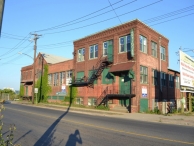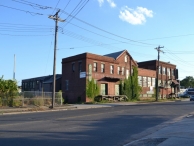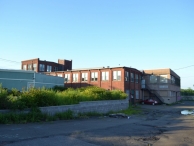Mill Record West Haven
RETURN TO ‘FIND MILLS’Disclaimer: Content for these properties was compiled in 2014-2017 from a variety of sources and is subject to change. Updates are occasionally made under Property Information, however the Connecticut Trust for Historic Preservation (dba Preservation Connecticut) makes no representation or warranty that the information is complete or up-to-date.
- Complex Name (Common)
- Royal Lounge Co. TO BE DEMO’d for Haven Mall 2019
- Complex Name (Historic)
-
- West Haven Mfg. Co.
- Address or Location
- 30 Elm Street, West Haven
- County
- New Haven
- Historic Designation
- Associated Mill Community
- n/a
- Historic Information
Companies Associated w/Complex
- Millers Falls Co. 1920-1931
- Royal Lounge Co. ca. 1950
- West Haven Mfg. Co. 1896-1920
Use (Historic)
Largest Documented Workforce
100-200 (1920).
Historic Narrative
The West Haven Manufacturing Company was organized by Frank S. Bradley in 1896. Bradley was born in Wethersfield, Connecticut on January 4, 1862, and was educated in the public schools of Wethersfield, Hartford, and Unionville, Connecticut, before he took a job at Unionville’s Standard Rule and Level Company at the age of 13. A mechanically talented individual and a gifted toolmaker, over the course of his career Bradley would also find employment at the Hartford Machine Screw Company, Colt Patent Firearms Manufacturing Company, and the Pratt and Whitney Company in Hartford, as well as at the Wetmore Machine Company, Henry G. Thompson Company, and R.H. Brown and Company in New Haven, Connecticut. While employed by these firms, Bradley constantly developed and patented a variety of machine tools of his own design, which eventually led to his decision to pursue an independent career path in 1896. Bradley established his shop in West Haven, which initially manufactured saw blades and bodies. He occupied a former key factory operated by G.W. Tuttle and worked alone for some six years before taking on a partner, Charles E. Graham, a native of Branford, Connecticut, who along with Bradley incorporated the West Haven Manufacturing Company in 1902. A businessman by trade, Graham served as president and treasurer of the firm, while Bradley operated as its secretary and general manager. The company developed and manufactured a diverse line of tools and hardware and employed between 100 and 200 hands during the early decades of the 20th century. One of the most notable products manufactured by the West Haven Manufacturing Company was a line of belt-driven power hacksaws marketed under the brand names of ‘Acme’ and ‘Universal.’ The firm also produced a line of hacksaw blades under the Universal brand that were marketed as the ‘the best hack saw blade on earth.’ The quality of the product eventually drew the attention of the Massachusetts-based Millers Falls Company, which acquired the West Haven Manufacturing Company in 1920 after the former firm parted ways with the primary supplier of saw blades used in the firm’s hacksaws. The Millers Falls Company continued to operate the Elm Street factory as a branch location until 1931, when the plant was closed and its machinery and general manager, William H. Shortell, were transferred to Greenfield, Massachusetts. The West Haven mill housed a variety of commercial tenants during the 1930s, and was occupied by the Royal Lounge Company, a New Haven furniture manufacturer, during the 1950s. The plant is currently vacant.
- Architectural Information
Number of Existing Buildings
Roughly seven (7) adjoining blocks.
Dates of Construction
ca. 1865, ca. 1902, ca. 1910, ca. 1940, ca. 1950.
Architect
n/a
Builder
n/a
Building Type
Architectural Description
The former West Haven Manufacturing Company mill is comprised of roughly seven primary adjoining blocks located on the south side of Elm Street (CT Route 122), approximately 200’ east of Elm Street’s intersection with Water Street. The two earliest blocks were erected for a key factory ca. 1865. They consist of a two-story, 27’ x 62’ red brick manufacturing building and a one-story, 20’ x 33’ red brick boiler house adjoining its southeast corner. The manufacturing block fronts on Elm Street and has rectangular window openings with heavy stone sills and lintels, two-over-two double-hung wood windows, a denticulated and corbelled brick cornice with cornice returns, and a front-facing gable roof. A two-story, 25’ x 30’ red brick addition was erected on the east side of the main block ca. 1902. This is similar in design to the original mill yet has one-over-one double-hung windows, a brick parapet with concrete coping, and a flat roof. The next major addition to the plant was likely completed during the 1910s. It consists of two red brick blocks built on the western side of the mill. A two-story, 42’ x 34’ machine shop is located at the northwest corner of the plant along Elm Street, and a one-story, 42’ x 100’ machine shop adjoins its south elevation. The two-story block is of brick pier construction and has a raised basement level, paired windows set in rectangular openings with stone sills, a broad denticulated and corbelled brick cornice, and a low-pitch gable roof that is hidden behind a tall brick parapet. The primary entrance to the mill is located on the western side of the block’s façade (north elevation) and is sheltered by a shed-roofed portico supported by heavy scroll-cut brackets. The rear block is of more restrained styling. Its ornamentation is limited to denticulation at the top of the full-height window bays and scroll-cut brackets supporting the low-pitch gable roof. The final additions to the plant include a one-story, 30’ x 62’ red brick block erected along Elm Street between the ca. 1865 and ca. 1910 blocks around 1940, and a one-and-a-half-story 72’ x 94’ concrete block manufacturing building built on the south side of the mill ca. 1950. The former is notable for its modern styling and the tall window openings with multi-pane metal sash that span the full width of the building. The rear block is faced with stucco and has large window openings, multi-pane metal sash with hopper-style openings, and a flat roof.
Exterior Material(s)
Structural System(s)
Roof Form
Roof Material
Power Source
Condition
Fair
Condition Notes
The complex is in fair condition. Although sections of the exterior walls are in need of cleaning and minor repairs, the mill appears to be structurally sound. A number of the original wood or metal windows remain, however, most are in dire need of repairs.
- Property Information
-
Specific Location
One 0.88 acre parcel on the south side of Elm Street just east of Water Street
Adjacent To
Exterior Visible from Public Road?
Yes
Parcel ID / Assessor Record Link
- 050/0039/0/0000. / Link →
Acreage
0.88
Use (Present)
- Sources
-
Form Completed By
Lucas A. Karmazinas
Date
08/04/2015
Bibliography
- List of Connecticut Manufacturers, 1922, 1924, 1930, 1932.
- Directory of Connecticut State Manufacturers, 1936, 1939.
- Industrial Directory of Connecticut, 1947.
- Register of War Production Facilities in Connecticut, 1951.
- Map of New Haven County; Clark, Richard, 1859.
- Atlas of New Haven County, Beers, Ellis & Soule, 1868.
- Aerial Survey of Connecticut, 1934, 1965.
- Sanborn Map Company, 1901, 1923, 1951.
- History of the City of New Haven to the Present Time, 1887.
- A Modern History of New Haven and Eastern New Haven County, 1920.
- Representative View(s)Click on image to view full file







